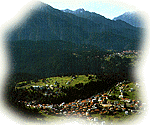 |


|
|
VIGO DI CADORE |
|
| The name of this serene and restful alpine town, a vacation and tourist centre, clearly has a Roman origin (from vicus, village). The Roman presence is confirmed by archaeological finds, although the earliest evidence of a settlement here date from the 12th century: it was a school run by Priest Maurizio. The autonomous community's constitution was drafted in 1338. Until 1797 Vigo was the capital of the Centuria d'Oltrepiave and its history is marked by various disputes with the Friulans over the land of Campo Razzo and Cadin di Razzo. Two famous events of the Risorgimento took place here: during the anti-Austrian revolt of 1848 the Cadore people thwarted the Austrians' attempt to descend from Razzo and fought them on the Mauria; in 1866, after armistice had been signed, the last battle in the Third War of Independence was fought here, with volunteers from Cadore stopping the superior Austrian forces at Treponti. One of most important cultural institutions in Vigo is the Historical Library, the largest in Cadore, which was founded in 1892 by the scholar Antonio Ronzon. It boasts an archive filled with precious documents, among them more than 500 parchments. There are seven churches in town, the best-known among them is the church of Sant'Orsola, a national monument built in 1344-45 by Ainardo da Vigo and decorated with a cycle of 14th and 15th-century frescoes. There is the tiny church of Santa Margherita, built during the early 14th century in the meadows of Salagona on a quadrilateral floorplan and decorated with frescoes depicting events in the life of Santa Margherita; the parish church of San Martino, completed in 1559 in the upper part of town; the church of the Difesa ("of the Defence"), built in 1512 in fulfilment of a vow taken during the German invasion; the church of San Daniele; and two additional churches in the villages of Pelos and Piniè. Among Vigo's famous sons, beside Antonio Ronzon, were the cardinal and patriarch of Venice G.A.A. Piazza; the historian P. Da Rocco; and the painter Tommaso Da Rin. Together with the villages of Laggio , Pelos and Piniè, the capital is situated at a dominant position in the upper part of the Piave Valley, sheltering behind Mount Tudaio. From Vigo begins the climb of the Piova Valley up to the Casera Razzo plateau at 1,745m. It is an open, green plain with alpine cabins, a popular tourist attraction with lots of snow and modern ski facilities. Vigo also offers a fully-equipped bobsled race track. Entertaining folklore shows, cultural events and high-quality musical perfomances are staged at the Arena in Laggio.
|
||



 APT
APT